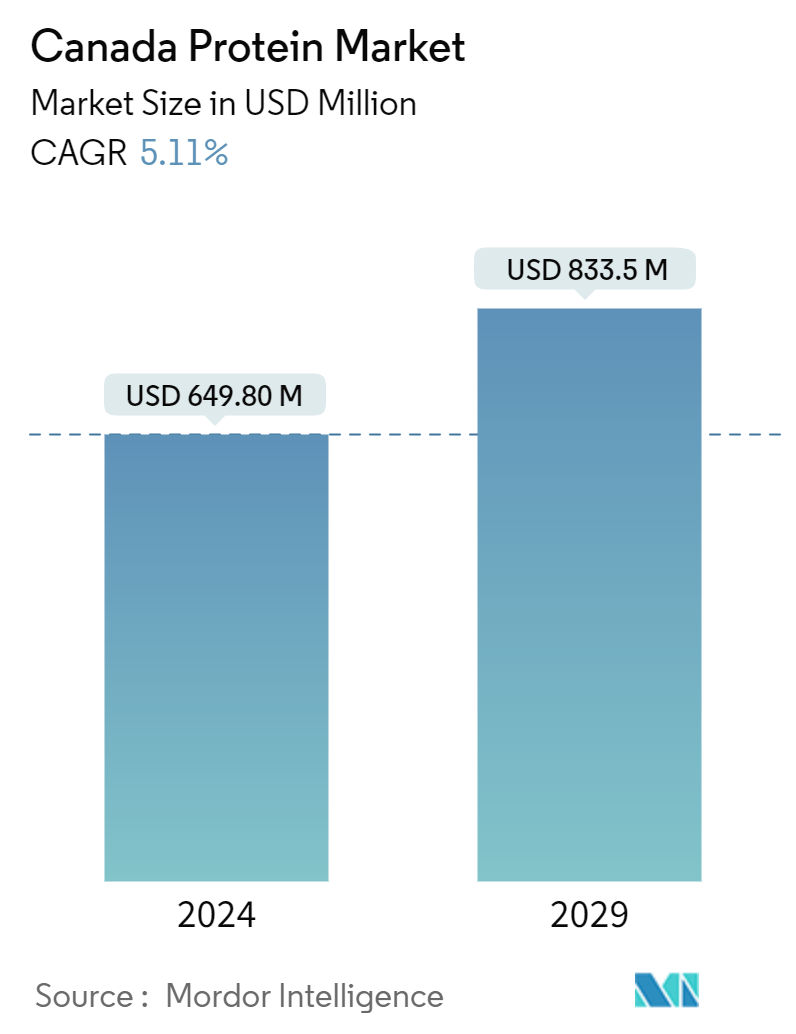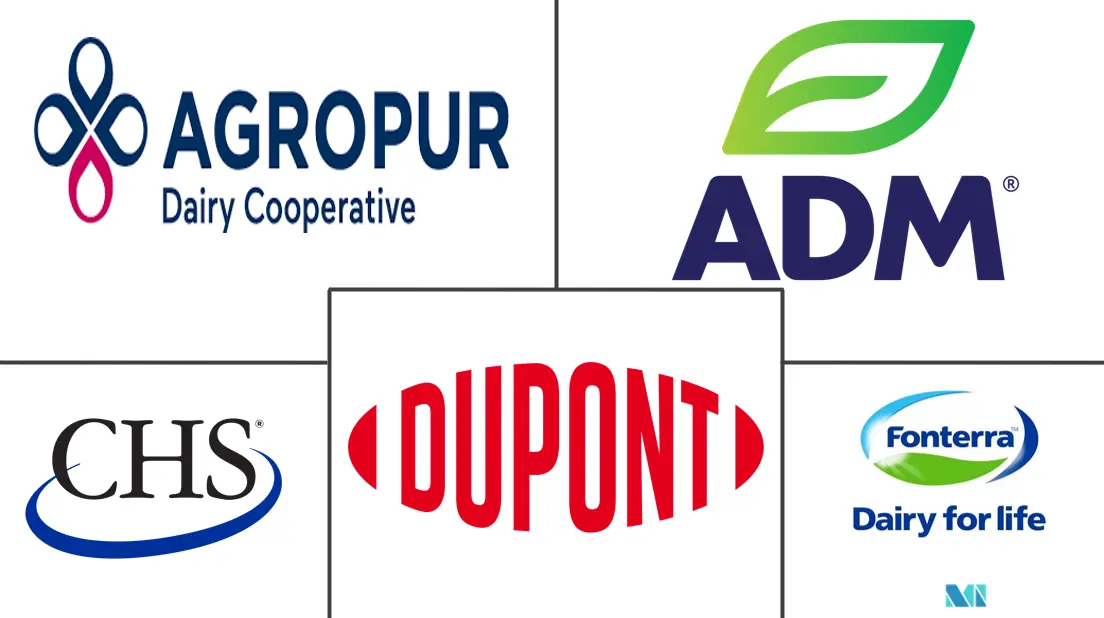Market Size of Canada Protein Industry

| Study Period | 2019 - 2029 |
| Market Size (2024) | USD 649.80 Million |
| Market Size (2029) | USD 833.5 Million |
| CAGR (2024 - 2029) | 5.11 % |
| Fastest Growing Market | Food and Beverages |
| Largest Market | Animal Feed |
| Market Concentration | High |
Major Players
*Disclaimer: Major Players sorted in no particular order |
Canada Protein Market Analysis
The Canada Protein Market size is estimated at USD 649.80 million in 2024, and is expected to reach USD 833.5 million by 2029, growing at a CAGR of 5.11% during the forecast period (2024-2029).
- The demand for protein-rich foods and supplements is fueling the growth of the protein market. Trends like the emergence of functional and fortified protein products, the popularity of plant-based protein, and the rising need for high-quality, sustainable protein sources have driven the protein market. Additionally, socioeconomic trends like growing urbanization, rising incomes, and aging populations are ultimately driving the increased protein consumption that is resulting from this population rise.
- Further, increasing the influence of social media to go green and go vegan is boosting the demand for plant-based protein alternatives among Canadian customers. The compatibility with vegetarian, vegan, and flexitarian lifestyles is now spotlighting plant-based protein sources, boosting the protein alternative market.
- Moreover, consumers and athletes are looking for natural and less processed nutritional solutions with proven benefits. Many protein manufacturing companies are launching new nutritional solutions to support sports nutrition manufacturers. For instance, in April 2023, Arla Foods Ingredients announced the launch of its new line of whey proteins branded as Nutrilac ProteinBoost, which is based on a patented microparticulation technology. The company claims that the products in the range have wide applications in the dairy and sports nutrition spaces, including yogurt, desserts, and dairy beverages.
Canada Protein Industry Segmentation
Protein is an essential macronutrient that plays a crucial role in the body, including building and repairing tissues, producing hormones and enzymes, and supporting immune function.
The Canada Protein market is segmented by source and end-user. Based on source, the market is segmented by animal, microbial, and plant. Based on animal sources, the market is further segmented into casein and caseinates, collagen, egg protein, gelatin, insect protein, milk protein, whey protein, and other animal protein. Based on microbial sources, the market is further segmented into algae protein and mycoprotein. Based on plant sources, the market is further segmented into hemp protein, oat protein, pea protein, potato protein, rice protein, soy protein, wheat protein, and other plant protein. Based on end-users, the market is segmented into animal feed, personal care and cosmetics, food and beverages, and supplements. The end-user food and beverages segment is further sub-segmented into the bakery, beverages, breakfast cereals, condiments/sauces, confectionery, dairy and dairy alternative products, meat/poultry/seafood and meat alternative products, RTE/RTC food products and snacks. The end-user supplements segment is further sub-segmented into baby food and infant formula, elderly nutrition and medical nutrition, and sport/performance nutrition.
For each segment, the report offers the market size in value terms in USD and volume terms in tons for all the abovementioned segments.
| Source | ||||||||||
| ||||||||||
| ||||||||||
|
| End-User | |||||||||||
| Animal Feed | |||||||||||
| Personal Care and Cosmetics | |||||||||||
| |||||||||||
|
Canada Protein Market Size Summary
The Canada protein market is experiencing significant growth, driven by an increasing demand for protein-rich foods and supplements. This demand is fueled by trends such as the rise of functional and fortified protein products, the growing popularity of plant-based proteins, and the need for high-quality, sustainable protein sources. Socioeconomic factors like urbanization, rising incomes, and an aging population are contributing to increased protein consumption. The influence of social media promoting vegan and eco-friendly lifestyles is further boosting the demand for plant-based protein alternatives, which are gaining traction among consumers following vegetarian, vegan, and flexitarian diets. The market is also seeing innovations in nutritional solutions, with companies like Arla Foods Ingredients launching new whey protein products aimed at the dairy and sports nutrition sectors.
The sports nutrition industry in Canada is a key driver of protein market growth, as more Canadians engage in fitness activities and seek protein to support muscle growth and recovery. Whey protein, in particular, is favored for its rapid absorption and high content of branched-chain amino acids, which aid in muscle synthesis. The import of whey protein into Canada underscores the increasing protein demand. Additionally, the popularity of protein bars, promoted as meal replacements by fitness clubs, is contributing to market expansion. The protein additives market in Canada is highly fragmented, with both international and regional players introducing innovative products, particularly those using natural and plant-based proteins. Collaborations and partnerships, such as those between Protein Industries Canada and Innovate UK, are further driving innovation in the plant-based food industry.
Canada Protein Market Size - Table of Contents
-
1. MARKET DYNAMICS
-
1.1 Market Drivers
-
1.1.1 Increasing consumer health conciousness
-
1.1.2 Growing consumer inclination toward Vegan/Plant-Based Proteins
-
-
1.2 Market Restraints
-
1.2.1 Stringent government regulation of food labels/claims
-
-
1.3 Porter's Five Forces Analysis
-
1.3.1 Bargaining Power of Suppliers
-
1.3.2 Bargaining Power of Buyers/Consumers
-
1.3.3 Threat of New Entrants
-
1.3.4 Threat of Substitute Products
-
1.3.5 Intensity of Competitive Rivalry
-
-
-
2. MARKET SEGMENTATION
-
2.1 Source
-
2.1.1 Animal
-
2.1.1.1 Casein and Caseinates
-
2.1.1.2 Collagen
-
2.1.1.3 Egg Protein
-
2.1.1.4 Gelatin
-
2.1.1.5 Insect Protein
-
2.1.1.6 Milk Protein
-
2.1.1.7 Whey Protein
-
2.1.1.8 Other Animal Protein
-
-
2.1.2 Microbial
-
2.1.2.1 Algae Protein
-
2.1.2.2 Mycoprotein
-
-
2.1.3 Plant
-
2.1.3.1 Hemp Protein
-
2.1.3.2 Oat Protein
-
2.1.3.3 Pea Protein
-
2.1.3.4 Potato Protein
-
2.1.3.5 Rice Protein
-
2.1.3.6 Soy Protein
-
2.1.3.7 Wheat Protein
-
2.1.3.8 Other Plant Protein
-
-
-
2.2 End-User
-
2.2.1 Animal Feed
-
2.2.2 Personal Care and Cosmetics
-
2.2.3 Food and Beverages
-
2.2.3.1 Bakery
-
2.2.3.2 Beverages
-
2.2.3.3 Breakfast Cereals
-
2.2.3.4 Condiments/Sauces
-
2.2.3.5 Confectionery
-
2.2.3.6 Dairy and Dairy Alternative Products
-
2.2.3.7 Meat/Poultry/Seafood and Meat Alternative Products
-
2.2.3.8 RTE/RTC Food Products
-
2.2.3.9 Snacks
-
-
2.2.4 Supplements
-
2.2.4.1 Baby Food and Infant Formula
-
2.2.4.2 Elderly Nutrition and Medical Nutrition
-
2.2.4.3 Sport/Performance Nutrition
-
-
-
Canada Protein Market Size FAQs
How big is the Canada Protein Market?
The Canada Protein Market size is expected to reach USD 649.80 million in 2024 and grow at a CAGR of 5.11% to reach USD 833.5 million by 2029.
What is the current Canada Protein Market size?
In 2024, the Canada Protein Market size is expected to reach USD 649.80 million.

